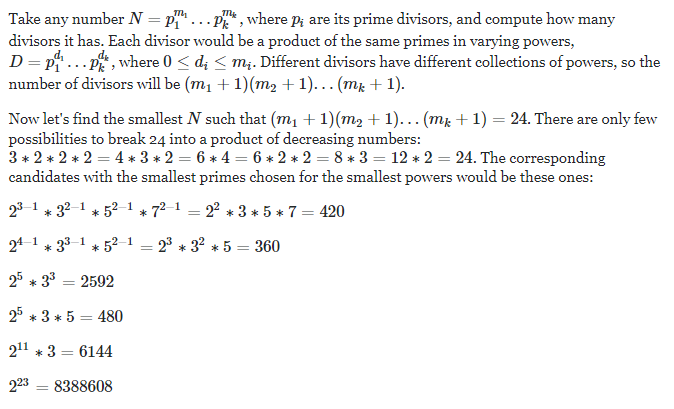‘1’ is neither prime nor composite. Thus x>=k should be correct.
How about 26 ? The prime factors are 2 and 13. Square root of 26 is between 5 and 6. One of the prime factors is 13 which is greater than 6. The number 26 isn’t prime either.
read my next comment
What is the use of assert ? (Setter’s solution).
Can you elaborate your doubt please? Frankly I didn’t even read the editorial until your comment, whatever I referred is from the following proof(Smallest number with specific number of divisors - Mathematics Stack Exchange), the following proof gave me the hint :

By the above proof, what I have understood according to our given problem is :
For given number X we can get factors between 1 and n (where n is maximum number of divisors of X), if k<=n then print(1) else print(0)
Now can you please elaborate your doubt?
still doesnt work
i want to know why you have written
if x>1:
cnt+=1
please explain me this?
while i*i <= x:
while x%i==0:
x //= i
cnt += 1
i += 1
Even after the above while block if still x value is greater than 1 means the final value of the x from the above block is a prime number, you can check with the simple TC for the given problem : Take X=2 and K=1.
Edit : After the while loop, still if x>1 then this can be a prime number and is a prime factor of the given value.
That is for the prime number case. Because the only number remaining after for and while loop can be a prime number.
I had to consider a lot of boundaries and approximations but logically it gave the right answer and my solution got AC.
Achieving the 1st sub-task was quite easy and doesn’t require that many boundaries, it was asked for K<=2.
So for any integer which is greater than 1 and is a prime number, has exactly 1 prime number and it’s X is 2( 1 and the prime itself). Talking about 2, as a result of the analysis, any integer greater than 1 and is not a prime number has at least 2 prime numbers as it’s factors.
and for the 2nd sub-task which had K>2, I had to use recursion which is explained in details
My Solution :- CodeChef: Practical coding for everyone
By the way thanks @taran_1407 for mentioning the concepts related to the problem this will surely help me out in a better way.
if(x > 1) cnt++;
why this line again?
After the loop, still if x value is greater than 1 means the final value of the x is a prime number and it is a prime factor of a given original value.
You can check with the simple TC for the given problem : Take X=2 and K=1.
please help me what is wrong with my approach I am getting partially correct result, correct only for subtask 1.
My approach A = p1^a1.p2^a2…pk^ak where p1,p2…pk are k prime numbers and a1,a2,…ak are there frequencies.
Now ai >=1 for that prime number to exist in K prime numbers
Now X which is total number of factors of A, X = (a1+1).(a2+1)…(ak+1), now ai>=1,
So X >= 2^k.
Some edge case-
X can only attain a prime value if k is 1, else X is always a composite number.
Based on this approach here goes my solution.
`# include<bits/stdc++.h>
define int long long
using namespace std ;
int32_t main()
{
int t ; cin>>t ;
while(t–)
{
int x,k ; cin >> x >> k ;
bool isPrime = true ;
for(int i=2;i<=sqrt(x);i++)
{
if((x%i) == 0) { isPrime = false ; break; }
}
int minV = pow(2,k) ;
if((isPrime && k>1) || (x < minV)) cout << 0 << endl ;
else cout << 1 << endl ;
}
}`
Please tell me what am I missing.
Thanks In Advance
can you provide a code for the same i have tried so many ways
First, make a simple bool function that checks whether the given integer is prime.
bool prime(long long int n)
{
if(n%2==0)
{
return 0;
}
for(long long int i=3; i<=sqrt(n); i+=2)
{
if(n%i==0)
{
return 0;
}
}
return 1;
}
Then, create another function that counts no. of prime divisors using the previously defined bool function
long long int primeFactors(long long int n)
{
long long int count=0;
while(n%2==0)
{
count++;
n/=2;
}
for(long long int i=3; i<=sqrt(n); i=i+2)
{
if(n%i==0 && prime(i))
{
while(n%i==0)
{
count++;
n/=i;
}
}
}
if(n>2)
{
count++;
}
return count;
}
This part is incorrect. Think why.
I don’ t get this part at all. Can someone provide me with some invaluable insight?
where is your code
my bad i didn’t consider an edge case hehe… i wont waste ur time now.